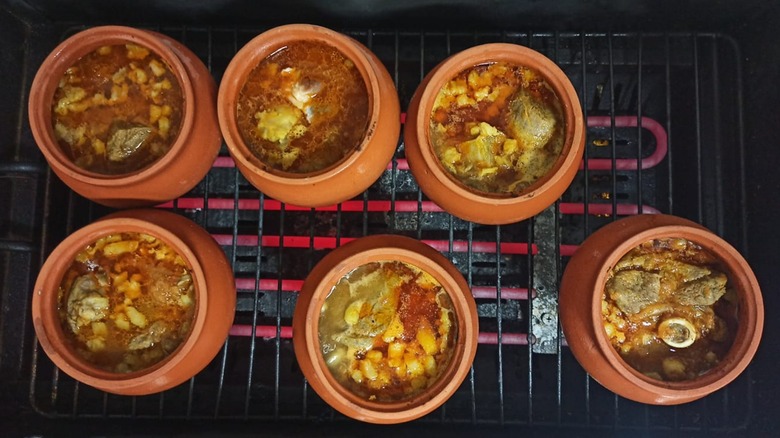The Afghani Lamb Dish Traditionally Cooked In A Clay Teapot
For centuries, Afghanistan had been an epicenter for trade routes and cultural infusion between Asia, the Middle East, and Europe. As a place of convergence and cultural exchange, Afghan culture has been deeply influenced by these factors, and its rich and diverse cuisine is no exception.
According to SBS, Persia, India, and Mongolia had the strongest influence on Afghan cuisine, and their legacy can be seen today in many flavorful dishes. As per the site, India primarily introduced spices like saffron, garam masala, and pepper. Persia contributed many green herbs and Mongolia gave the nation many doughy dumplings and noodle dishes. However, this does not mean that Afghan cuisine is simply a replica of these countries' dishes. Rather, it has incorporated these ingredients into its own renditions of beautifully complex traditional foods that are frequently fatty, warm, and full of dried fruit and nuts.
One of the most traditional Afghan foods is known as chainaki, a chunky lamb stew full of meat, fat, vegetables, and spices, per Whetstone. Chainaki's name comes from the chainak, the name of the clay teapot the meal slowly cooks in. This dish is integral to the culinary history of Afghanistan, but its origins remain murky.
History of chainaki
Unfortunately, Afghanistan is a country that has been plagued by numerous grueling wars and has become known for that story rather than its culinary or cultural one. As per the Cato Institute, the country has suffered through decades of uninterrupted war, and this trauma has had a drastic impact on Afghan culture.
Many famous and traditional dishes in the nation, including chainaki, are not an exception to any traumatic amnesia. Whetstone Magazine quotes Afghani chef Hamidullah Noori who notes the dish's origins come from the capital of Kabul, where the dish soon spread around to smaller villages throughout the country. However, it is hard to get more specific than that. The chef says, "Because we've had so many wars in the country for decades, the problem with Afghani cuisine is we lost our mentions ... Nobody mentioned [or wrote down] the names of people making things."
While the exact history is likely lost, the dish is still a relevant and important cultural and traditional experience that continues to be enjoyed by Afghans and shared across the globe. As the Los Angeles Times describes it, chainaki is "tradition in action." Through the many wars, chainaki makers have continued to open their doors and serve a hungry public. The classic chainaki serves as a great comfort food with warm naan soaking up the savory goodness.
Ingredients in chainaki
This savory stew is freshly prepared in clay pots, not metal or any other substance, for the ideal taste and texture (per Los Angeles Times). The main ingredient in the stew is lamb, including large chunks of perfectly cut meat and fat. Kabul chainaki seller, Waheed Merzazadah, told the outlet, "Afghans, we love lamb meat. It's like hashish for us — it makes you high." No other oil is used besides the pieces of lamb fat to drive home the lamb flavor throughout the dish.
Whetstone Magazine notes that this tender meat is cooked alongside plenty of vegetables and spices. The ingredients list can include "chopped onions, garlic, ginger, turmeric, coriander, celery, tomatoes, and cilantro." Aside from these hearty main ingredients, a bit of water is added before the pot is placed over a flame for several hours to aid the cooking process. Salt and pepper can also be sprinkled in to taste.
How chainaki is made and eaten
It takes years of proper training to master the ideal chainaki dish, according to Los Angeles Times. And, the process is laborious. For many chainaki makers, the day starts in the early hours, often around 3 a.m. The first part of the day involves pulling out the freshly cut lamb pieces that had been prepared the night before. Then, it's time to prepare the vegetables, and other ingredients, by cutting and dividing them up amongst the prepared chainaks. Once the clay pots are filled with the meat, fat, and veggies, they will slow cook for several hours.
The cooking ends around noon, perfect for the lunchtime rush. For those few midday hours, doling out the hundreds of prepared chainakis takes up the majority of time for these sellers. Once the rush is over, preparations for the next day begin until evening hours. Despite the intensive preparation, chainaki is a very cheap street food dish that can often be purchased for around $2, as per Heated.
There is a proper way to consume this dish, and it does not involve simply dipping warm naan into the broth. To eat it correctly, naan must line the bottom of the soup bowl as the stew is poured over it from the chainak. Then, before the liquid renders the naan completely unusable, the infused naan should be used to scoop up the larger pieces of stew and to carry it toward the mouth.



